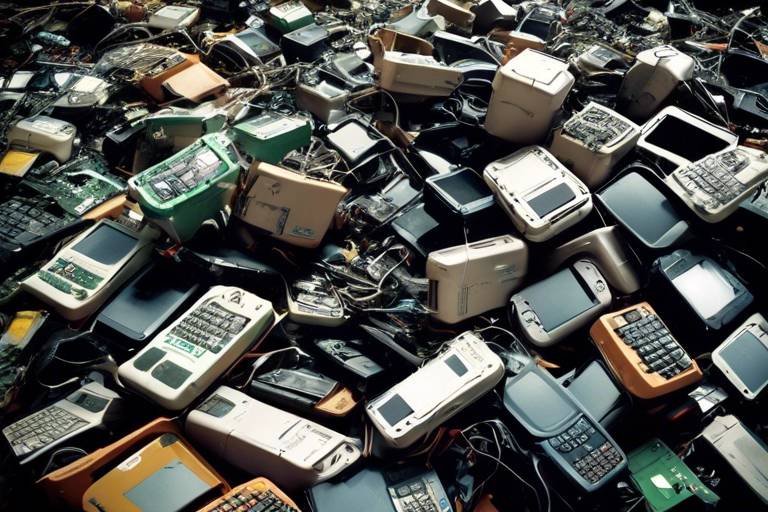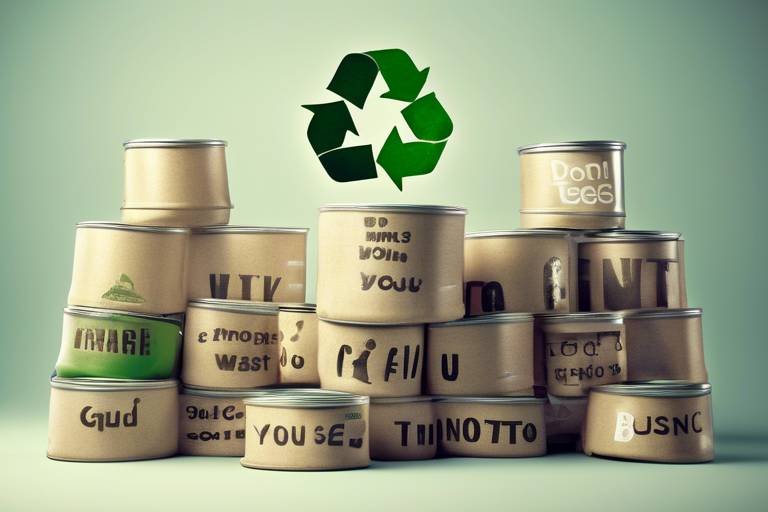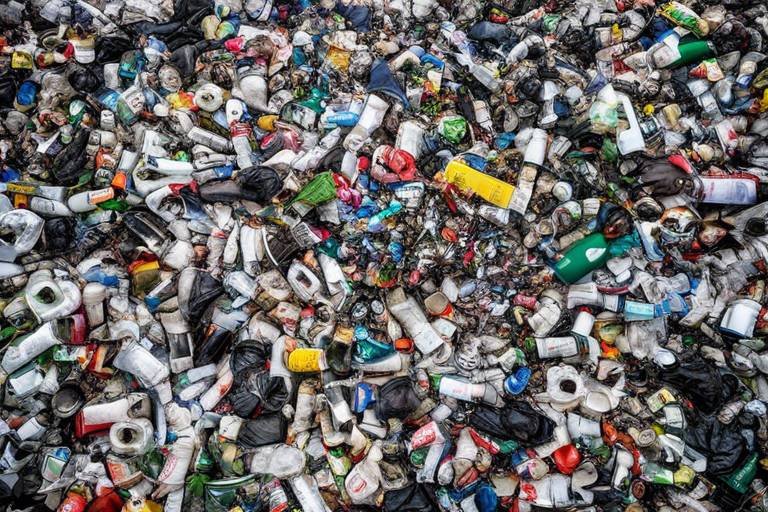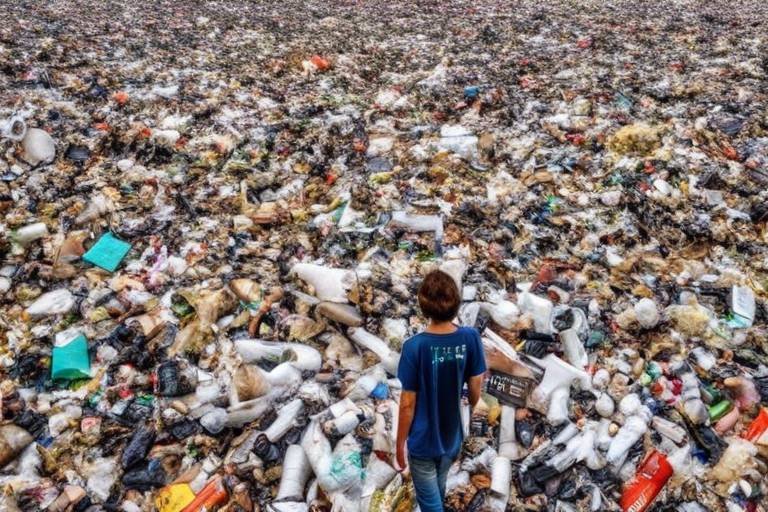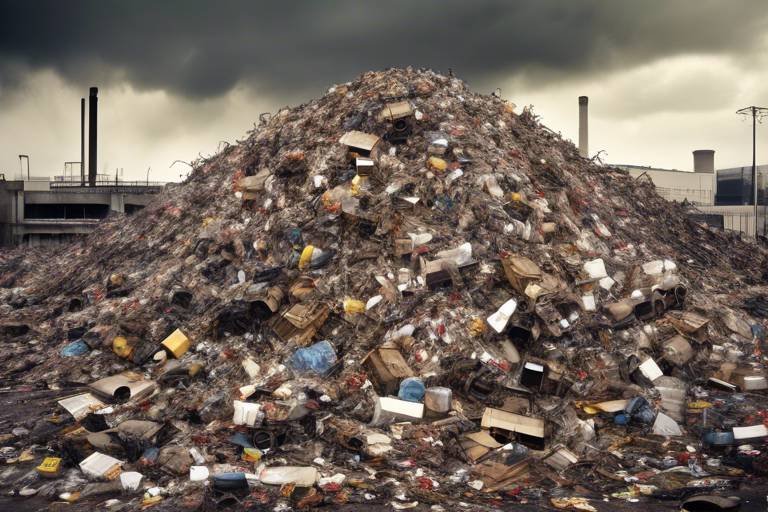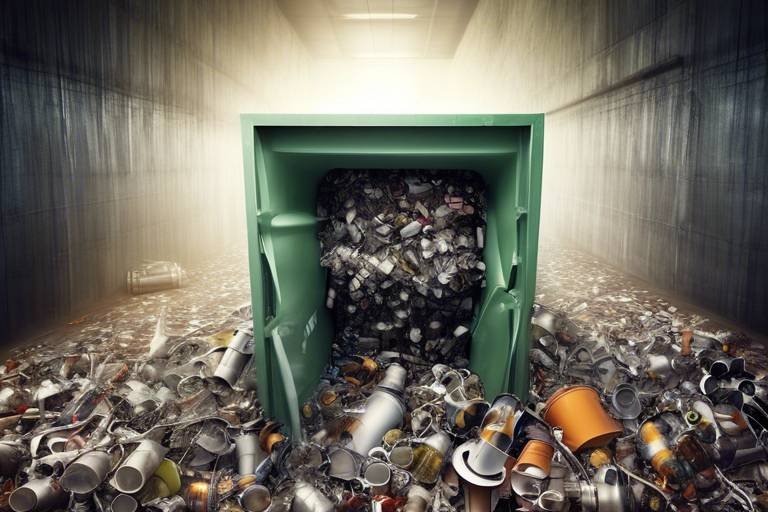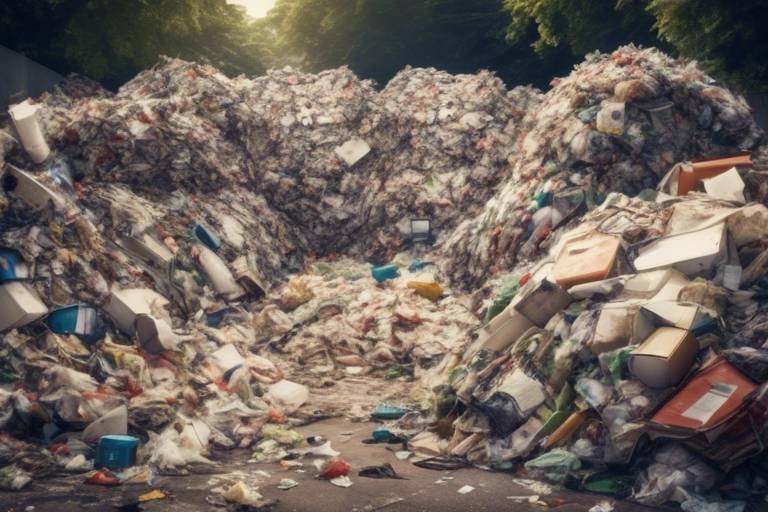How Can You Help in Reducing E-Waste
In our tech-driven world, electronic devices have become indispensable, yet they also contribute significantly to the growing problem of electronic waste, or e-waste. So, how can you, as an individual, make a difference in reducing this environmental threat? It all starts with awareness and action. By understanding the impact of e-waste and adopting responsible practices, you can play a vital role in minimizing its accumulation. Think of it this way: just like a pebble creates ripples in a pond, your small actions can lead to significant changes in the ecosystem.
First and foremost, it’s essential to recognize what e-waste encompasses. It’s not just old computers and phones; it includes any discarded electronic devices such as televisions, printers, and even kitchen appliances. These gadgets often contain hazardous materials that can leach into the environment, posing serious health risks. By taking steps to reduce e-waste, you’re not only protecting the planet but also safeguarding your community.
One of the most impactful ways to help is through responsible disposal. Instead of tossing your old electronics in the trash, consider recycling them. Recycling e-waste allows valuable materials like gold, silver, and rare earth metals to be recovered, reducing the need for new resource extraction. It’s like mining in reverse—saving the Earth’s resources rather than depleting them. Not to mention, recycling prevents harmful substances from entering landfills, where they can contaminate soil and water.
Additionally, you can explore repurposing your old devices before deciding to get rid of them. For instance, an old smartphone can transform into a dedicated music player, a digital photo frame, or even a home security camera. By giving your electronics a new lease on life, you're extending their usefulness and delaying their journey to the landfill.
Moreover, making informed purchasing decisions can greatly reduce e-waste. When buying electronics, consider the longevity and sustainability of the products. Opt for brands that prioritize eco-friendly practices and offer durable products. This not only minimizes waste but also encourages manufacturers to adopt greener approaches. Remember, every time you choose a sustainable product, you’re casting a vote for a healthier planet.
In summary, reducing e-waste is a collective effort that starts with you. By understanding the importance of responsible disposal, recycling, and making sustainable purchasing choices, you can contribute to a cleaner, greener future. So the next time you upgrade your device, think twice before you toss the old one aside. Your actions matter, and together, we can make a significant impact in the fight against e-waste.
- What is e-waste? E-waste refers to discarded electronic devices that are no longer in use, such as old computers, phones, and appliances.
- Why is recycling e-waste important? Recycling helps recover valuable materials and prevents hazardous substances from harming the environment.
- How can I find a local recycling center? You can search online for local e-waste recycling centers or check with your city’s waste management department.
- What should I do with old electronics that still work? Consider donating them to local charities or repurposing them for new uses.
- Are there brands that focus on sustainability? Yes, many companies prioritize eco-friendly practices and offer sustainable products. Look for certifications and reviews.

Understanding E-Waste
E-waste, or electronic waste, is a term that encompasses all discarded electrical and electronic devices. This includes everything from old smartphones and laptops to outdated televisions and refrigerators. As technology advances at lightning speed, we find ourselves upgrading our gadgets more frequently than ever. This leads to a staggering amount of e-waste being generated each year. In fact, according to the Global E-Waste Monitor, approximately 53.6 million metric tons of e-waste was produced globally in 2019, and that number is projected to rise significantly in the coming years.
The impact of e-waste on our environment is profound and alarming. Many of these discarded devices contain hazardous materials such as lead, mercury, and cadmium, which can leach into the soil and water, posing serious health risks to humans and wildlife alike. For instance, when electronic items are improperly disposed of, these toxic substances can contaminate local ecosystems, leading to long-term environmental damage. It's a bit like tossing a ticking time bomb into your backyard; you might not see the immediate effects, but over time, the consequences can be devastating.
Understanding e-waste is not just about recognizing what it is; it’s also about grasping the urgency behind responsible disposal and recycling. By taking the time to understand the implications of our electronic consumption, we can make better choices that contribute to a healthier planet. One of the most effective ways to combat e-waste is through recycling. When we recycle our old electronics, we are not only preventing harmful materials from entering landfills but also recovering valuable resources like gold, silver, and rare earth elements. These materials can be reused in the production of new devices, reducing the need for mining and minimizing our overall environmental footprint.
To put it simply, we have a responsibility to ensure that our electronic devices don’t end up as toxic waste. Instead, we should aim to create a circular economy where products are designed for longevity and recyclability. This shift not only helps the environment but also fosters innovation in sustainable technology. The more we educate ourselves about e-waste and its effects, the better equipped we are to take action. So, the next time you think about upgrading your device, ask yourself: What happens to my old one? Taking a moment to consider the lifecycle of your electronics can lead to more sustainable choices and ultimately, a healthier planet for future generations.

Importance of Recycling
Recycling e-waste is not just a trend; it's a vital practice that can help protect our planet. When we talk about e-waste, we're referring to discarded electronic devices like smartphones, laptops, and televisions. These items often contain hazardous materials such as lead, mercury, and cadmium, which can seep into our soil and waterways, causing significant environmental damage. By recycling, we can mitigate these risks and contribute to a healthier ecosystem.
One of the most compelling reasons to recycle e-waste is the recovery of valuable materials. Did you know that your old gadgets could contain precious metals like gold and silver? According to recent studies, up to 60% of the world’s gold supply comes from electronic waste. When we recycle, we can reclaim these materials, reducing the need for mining new resources, which is often destructive to the environment. This process not only conserves natural resources but also saves energy. For instance, recycling aluminum saves up to 95% of the energy required to produce new aluminum from raw materials.
Moreover, effective e-waste recycling can significantly reduce the amount of waste sent to landfills. When electronics are tossed into landfills, they take years to decompose, and in the process, they can release harmful substances into the environment. To put this in perspective, consider this: the average American produces about 7.1 pounds of e-waste each year. If we all committed to recycling even half of that amount, we could collectively divert millions of tons of e-waste from landfills.
Additionally, recycling e-waste supports the economy. The recycling industry creates jobs in collection, sorting, and processing, which contributes to local economies. Not only does this help in job creation, but it also fosters innovation in recycling technologies. Many companies are investing in more efficient recycling methods, which can lead to even greater recovery rates of materials.
In summary, the importance of recycling e-waste cannot be overstated. It protects our environment, conserves resources, reduces landfill waste, and stimulates economic growth. By making a conscious effort to recycle our old electronics, we can all play a part in creating a more sustainable future. So, the next time you upgrade your device, think twice about what happens to the old one. Remember, recycling is a simple yet powerful way to make a difference!
- What types of e-waste can be recycled? Most electronic devices can be recycled, including smartphones, computers, televisions, and even small appliances.
- How can I find a recycling center near me? You can search online for local recycling centers or check with your municipality for designated e-waste collection events.
- Are there any costs associated with recycling e-waste? Many recycling centers offer free services, but some may charge a fee for certain items. It's best to check in advance.
- What should I do with my personal data before recycling? Always wipe your devices clean of personal data before recycling. You can do this by performing a factory reset or using data-wiping software.

How to Recycle E-Waste
Recycling e-waste is not just a responsible act; it’s a necessity in our digital age. With technology evolving at lightning speed, old devices often pile up, becoming obsolete before we even have a chance to fully utilize them. But fear not! There are straightforward steps you can take to ensure that your discarded electronics are handled properly. First and foremost, it’s essential to understand that not all recycling facilities are created equal. Some may not have the appropriate means to recycle e-waste safely, potentially harming the environment instead of helping it. So, how do you navigate this maze of recycling options? Let’s break it down.
To start, you should identify the types of e-waste you have at home. This could range from old smartphones and laptops to televisions and printers. Each of these devices may require different recycling processes, so knowing what you’re dealing with is crucial. Once you have a clear inventory, you can take the next step: finding a reputable recycling center. Many municipalities have designated e-waste collection days, where you can drop off your items safely. Additionally, there are numerous online resources that can help you locate nearby recycling centers.
For those who prefer a more hands-off approach, many electronics manufacturers have implemented take-back programs. These initiatives allow you to return your old devices directly to the manufacturer, ensuring they are recycled responsibly. Not only does this save you the hassle of finding a recycling center, but it also often comes with perks, such as discounts on future purchases. For example, companies like Apple and Dell have established programs that streamline the recycling process, making it easier than ever for consumers to do their part.
But wait, there’s more! If you’re feeling creative, consider repurposing your old electronics before you recycle them. For instance, an old smartphone can be transformed into a dedicated music player or a home security camera. This not only extends the life of your device but also reduces the amount of e-waste generated. It’s a win-win situation!
In summary, recycling e-waste is a vital step in protecting our planet. By identifying your devices, locating proper recycling centers, utilizing manufacturer take-back programs, and considering repurposing options, you can significantly contribute to reducing electronic waste. Remember, every small action counts in the fight against e-waste!
- What types of electronics can be recycled? Most electronic devices, including computers, smartphones, televisions, and batteries, can be recycled. Check with your local recycling center for specific guidelines.
- Are there any costs associated with e-waste recycling? Many local recycling programs are free, but some manufacturers may charge a fee for certain items. Always check beforehand.
- Can I just throw my e-waste in the regular trash? No! Throwing e-waste in the trash can lead to harmful chemicals leaching into the environment. Always recycle it responsibly.
- What should I do with personal data on my devices? Before recycling, make sure to wipe your devices clean of personal data. Use factory reset options and consider using data-wiping software for extra security.

Local Recycling Centers
Finding local recycling centers is a crucial step in ensuring that your electronic waste is disposed of responsibly. These centers play an essential role in managing e-waste, helping to divert harmful materials from landfills and recover valuable resources. But how do you locate these facilities? It's easier than you might think!
First, you can start by visiting your city or county's official website. Many municipalities have dedicated sections for waste management that include directories of local recycling centers. Additionally, there are several online platforms that allow you to search for e-waste recycling options based on your zip code. Websites like Earth911 and RecycleNation are excellent resources that provide information on recycling locations and acceptable materials.
When you find a local recycling center, it’s important to check what types of electronics they accept. Most centers will take items like old computers, televisions, and smartphones, but some may have restrictions on certain products due to the hazardous materials they contain. Here’s a quick overview of common items that can typically be recycled:
- Computers and laptops
- Monitors and televisions
- Printers and scanners
- Mobile phones and tablets
- Video game consoles
Before heading out, it’s also wise to call the recycling center to confirm their operating hours and any specific guidelines they have in place. Some centers may require you to schedule an appointment or drop off your items during designated times. By taking these steps, you not only ensure that your e-waste is handled correctly but also support the local economy and community efforts in sustainability.
Moreover, many local recycling centers offer additional services such as data destruction for personal devices, which can provide peace of mind when disposing of sensitive information. This means you can recycle your old electronics while ensuring your personal data is secure. It’s a win-win situation!
In summary, locating a nearby recycling center is a simple yet impactful way to contribute to reducing e-waste. By being proactive in your search and understanding the recycling options available, you can play a significant role in protecting the environment and promoting sustainable practices in your community.
Q: What types of electronics can I recycle at local centers?
A: Most local recycling centers accept a variety of electronics, including computers, monitors, televisions, and mobile devices. It's best to check with your specific center for a complete list of accepted items.
Q: Is there a fee to recycle electronics?
A: Some recycling centers may charge a small fee for certain items, especially larger ones like televisions. However, many centers offer free recycling for smaller electronics. Always verify with the center beforehand.
Q: Can I drop off my e-waste anytime?
A: Many recycling centers have specific hours for drop-offs, and some may require appointments. It's advisable to check the center's operating hours before planning your visit.
Q: What happens to my e-waste after I drop it off?
A: Once your e-waste is collected, it is sorted and processed. Valuable materials like metals and plastics are recovered for reuse, while hazardous materials are disposed of safely to minimize environmental impact.

Manufacturer Take-Back Programs
Have you ever wondered what happens to your old electronics once they’ve outlived their usefulness? Thankfully, many manufacturers have stepped up to the plate with take-back programs. These initiatives are designed to make it easier for consumers to responsibly dispose of their electronic devices, ensuring that they don’t end up in landfills where they could leach harmful chemicals into the soil and water. Instead, these programs allow you to return your used electronics directly to the manufacturer, who will then take on the responsibility of recycling or properly disposing of the materials.
So, how do these take-back programs work? It’s relatively straightforward. Most companies provide specific instructions on their websites regarding how to return your old devices. This usually involves:
- Checking if your device is eligible for the program.
- Packaging the device securely to prevent any damage during transit.
- Shipping it back to the manufacturer, often at no cost to you.
By participating in these programs, you’re not just getting rid of your old electronics; you’re also contributing to a larger effort aimed at reducing e-waste. Many manufacturers have established partnerships with certified e-waste recyclers to ensure that the materials are processed in an environmentally friendly manner. For instance, valuable metals like gold, silver, and copper can be extracted and reused, significantly reducing the need for new mining operations that can be harmful to the environment.
Additionally, take-back programs can vary widely from one manufacturer to another. Some companies might offer incentives, such as discounts on future purchases, for returning old devices. Others might have specific drop-off locations or events where you can bring your e-waste. To make things easier for you, here’s a quick comparison of some popular manufacturers and their take-back initiatives:
| Manufacturer | Take-Back Program Details | Incentives Offered |
|---|---|---|
| Apple | Free recycling for all devices; trade-in options available. | Gift cards for eligible devices. |
| Samsung | Offers mail-in recycling and drop-off locations. | Discounts on new purchases. |
| HP | Free shipping for returned devices; recycling kiosks available. | Rewards points for future purchases. |
In conclusion, participating in manufacturer take-back programs is a simple yet effective way to contribute to the reduction of e-waste. Not only do you help keep harmful materials out of landfills, but you also play a role in the circular economy, where resources are reused and recycled rather than wasted. So, the next time you’re about to toss that old gadget in the trash, think twice—check if the manufacturer offers a take-back program. Your small action can lead to a big impact!
Q1: What types of electronics can I return through take-back programs?
A1: Most take-back programs accept a wide range of electronics, including smartphones, laptops, tablets, and accessories. However, it’s best to check the specific guidelines provided by each manufacturer.
Q2: Is there a cost associated with returning my old electronics?
A2: Generally, most manufacturers cover the shipping costs for returning devices through their take-back programs, making it a free service for consumers.
Q3: What happens to my returned electronics?
A3: Returned electronics are typically sent to certified e-waste recyclers who will responsibly recycle or dispose of the materials, extracting valuable components and ensuring hazardous materials are handled correctly.
Q4: Can I participate in take-back programs if I didn’t buy the product directly from the manufacturer?
A4: Yes, most manufacturers allow you to return products regardless of where you purchased them, as long as they are eligible for the program.

Repurposing Electronics
Before you decide to toss that old smartphone or laptop into the trash, have you ever considered the potential hidden treasures lurking within? Repurposing electronics is not just a creative way to extend the life of your gadgets; it’s also a fantastic opportunity to reduce e-waste and save some cash! Think of your old devices as a box of building blocks. With a little imagination and effort, you can transform them into something new and useful.
For instance, an old tablet can be turned into a digital photo frame. Simply load it up with your favorite memories, set it to slideshow mode, and voilà! You have a beautiful display that adds a personal touch to your living room. Similarly, if you have a retired smartphone lying around, consider using it as a dedicated music player or a home security camera. There are countless apps available that can help you repurpose these devices effectively.
Another exciting option is to create a DIY smart home hub. With just a few tweaks and the right apps, you can turn an outdated laptop or desktop into a central control unit for your smart devices. This not only breathes new life into your old electronics but also enhances your home’s functionality.
Moreover, repurposing doesn’t have to be a solo endeavor. You can engage your community by organizing a tech swap event where people can exchange their old electronics and share ideas on how to repurpose them. This not only fosters creativity but also builds a sense of community and promotes sustainability.
To help you get started, here are a few more ideas for repurposing electronics:
- Old Monitors: Transform them into a second screen for multitasking or a digital art display.
- Broken Laptops: Use the hard drive as an external storage device or salvage parts for other projects.
- Game Consoles: Turn them into media centers for streaming your favorite shows and movies.
By embracing the concept of repurposing electronics, you not only contribute to reducing e-waste but also unleash your creativity. So, the next time you think about throwing away an old device, pause and consider how you might give it a new lease on life. Remember, every little effort counts in the fight against e-waste!
Q: What is e-waste?
A: E-waste refers to discarded electronic devices, including computers, smartphones, and household appliances, which often contain hazardous materials that can harm the environment.
Q: How can I recycle my old electronics?
A: You can recycle your old electronics by locating local recycling centers, participating in manufacturer take-back programs, or using mail-in recycling services offered by various companies.
Q: What are some creative ways to repurpose old electronics?
A: Some creative ideas include turning an old tablet into a digital photo frame, using a smartphone as a dedicated music player, or transforming a laptop into a smart home hub.
Q: Why is it important to reduce e-waste?
A: Reducing e-waste is crucial because it helps conserve natural resources, minimizes pollution, and protects the environment from hazardous materials found in electronic devices.

Responsible Purchasing Decisions
When it comes to reducing e-waste, one of the most powerful tools in your hands is the ability to make . It’s easy to get swept up in the latest tech trends and feel the pressure to upgrade your devices regularly. However, taking a moment to pause and consider the impact of your choices can make a significant difference. Think of it like planting a tree: the seeds you sow today will determine the shade you enjoy tomorrow. By being mindful of what you buy, you can contribute to a healthier planet and minimize the amount of electronic waste that ends up in landfills.
First and foremost, it's essential to recognize that not all electronics are created equal. Some brands prioritize sustainability and environmental responsibility, while others focus solely on profit margins. By choosing to support sustainable brands, you not only encourage eco-friendly practices but also send a message to the industry that consumers care about the environment. These brands often implement better manufacturing processes, use recyclable materials, and provide options for responsible disposal.
Another important factor to consider is the lifecycle of the product. Understanding how long a device is expected to last and how easily it can be recycled is crucial. For instance, some devices are designed with planned obsolescence, meaning they are intentionally made to have a shorter lifespan. On the other hand, products that are built to last and are easily recyclable can significantly reduce e-waste. When making a purchase, ask yourself: Will this device stand the test of time? Can it be recycled at the end of its life? This simple reflection can lead to more informed choices.
To further aid your decision-making process, consider the following criteria when evaluating electronics:
- Durability: Look for products that are built to last and come with warranties.
- Recyclability: Check if the manufacturer provides information on how to recycle the product.
- Energy Efficiency: Opt for devices that consume less power and contribute to lower energy bills.
- Repairability: Choose products that can be easily repaired instead of replaced.
By keeping these criteria in mind, you can significantly reduce your contribution to e-waste. Moreover, it’s worth noting that many manufacturers are now adopting more sustainable practices in response to consumer demand. This shift not only benefits the environment but also fosters a culture of sustainability within the tech industry. So, every time you make a conscious decision to purchase responsibly, you're not just buying a product—you're voting for a greener future.
In conclusion, responsible purchasing decisions are an essential part of the solution to e-waste. By choosing sustainable brands, understanding product lifecycles, and being mindful of your consumption habits, you can play a vital role in reducing electronic waste. Remember, every small step counts, and together, we can make a significant impact.
Q: What is e-waste?
A: E-waste refers to discarded electronic devices, such as computers, smartphones, and televisions, that can contain hazardous materials and contribute to environmental pollution.
Q: How can I recycle my old electronics?
A: You can recycle your old electronics by locating local recycling centers, participating in manufacturer take-back programs, or using specialized e-waste recycling services.
Q: Why is it important to choose sustainable brands?
A: Supporting sustainable brands encourages eco-friendly practices, reduces environmental impact, and promotes a market that prioritizes responsible manufacturing and disposal.
Q: What should I consider when buying new electronics?
A: Consider the product's durability, recyclability, energy efficiency, and repairability to make informed purchasing decisions that help reduce e-waste.

Choosing Sustainable Brands
When it comes to electronics, making sustainable purchasing decisions can feel like navigating a maze. With so many brands vying for your attention, how do you choose the ones that genuinely care about our planet? The first step is to look for companies that prioritize sustainability in their operations. These brands often implement eco-friendly practices, from sourcing materials responsibly to ensuring their products are recyclable at the end of their life cycle. By supporting these companies, you not only make a positive impact on the environment but also encourage other manufacturers to adopt similar practices.
One way to identify sustainable brands is by checking for certifications and labels that indicate a commitment to environmental responsibility. For instance, look for certifications like Energy Star, which signifies energy efficiency, or Electronic Product Environmental Assessment Tool (EPEAT), which evaluates electronic products based on their environmental impact. These labels can serve as a guide, helping you make informed choices while shopping.
Moreover, many sustainable brands are transparent about their supply chains and manufacturing processes. They often share information about how they minimize waste, reduce carbon footprints, and use renewable energy. By opting for brands that are open about their practices, you can feel confident that your purchase is contributing to a more sustainable future. It's like choosing a friend who shares your values—you're more likely to support them and their mission.
Additionally, consider the longevity of the products offered by these brands. Investing in durable electronics means you won't have to replace them as frequently, which ultimately reduces e-waste. Look for brands that offer warranties or guarantees, as these often indicate a commitment to quality. Remember, it's not just about buying the latest gadget; it's about choosing products that will stand the test of time.
As you shop, keep in mind that sustainability is not just a trend; it's a movement that requires our collective effort. By consciously choosing to support sustainable brands, you are casting a vote for a healthier planet. In doing so, you're not only enhancing your own life with quality products but also paving the way for future generations to enjoy a cleaner, greener world.
- What are some examples of sustainable electronics brands? Some well-known brands include Apple, Samsung, and HP, which have made strides in sustainability.
- How can I verify if a brand is sustainable? Look for certifications like Energy Star or EPEAT, and check the brand's website for sustainability reports.
- Why is it important to choose sustainable brands? Choosing sustainable brands helps reduce environmental impact, promotes ethical practices, and encourages companies to prioritize eco-friendliness.

Understanding Product Lifecycles
When it comes to making informed purchasing decisions, understanding the product lifecycle is paramount. The lifecycle of a product encompasses all stages, from its initial conception and production to its eventual disposal. This holistic view allows consumers to assess not only the quality and durability of an electronic device but also its environmental impact over time. By grasping the product lifecycle, you can become a more responsible consumer and contribute to reducing e-waste.
The lifecycle of a product can typically be broken down into several key phases:
- Design and Development: This is where the journey begins. Manufacturers design products with specific functionalities in mind. However, the materials chosen and the design's sustainability are critical factors that will affect the product's overall environmental footprint.
- Manufacturing: During this phase, raw materials are transformed into finished products. It's essential to consider whether the manufacturer uses sustainable practices and minimizes waste in their production processes.
- Distribution: Once manufactured, products are distributed to retailers. The transportation methods used can significantly impact a product's carbon footprint, so it’s worth considering how far the product has traveled to reach you.
- Usage: This is the phase where the consumer interacts with the product. Understanding how long a device is designed to last and how energy-efficient it is during usage can help you make better choices that align with sustainability.
- End-of-Life: Finally, every product reaches the end of its life. This phase is crucial for minimizing e-waste. Knowing how to properly dispose of or recycle your electronics can significantly reduce their environmental impact.
By examining these phases, you can ask yourself important questions before making a purchase:
- What materials are used in this product?
- Is the manufacturer committed to sustainable practices?
- How long is the expected lifespan of the product?
- What options do I have for recycling or disposing of this product when it's no longer useful?
Understanding product lifecycles not only empowers you as a consumer but also encourages manufacturers to adopt more sustainable practices. When consumers demand transparency and sustainability, companies are more likely to respond with eco-friendly innovations. This shift can lead to a significant reduction in e-waste, benefiting both the planet and future generations.
Q: What is a product lifecycle?
A: A product lifecycle refers to the stages a product goes through from its development to its disposal, including design, manufacturing, distribution, usage, and end-of-life.
Q: Why is understanding product lifecycles important?
A: Understanding product lifecycles helps consumers make informed decisions that can reduce e-waste and promote sustainable practices.
Q: How can I assess a product's sustainability?
A: Look for information on the materials used, the manufacturer's sustainability practices, energy efficiency during usage, and recycling options available for the product.
Frequently Asked Questions
- What is e-waste and why is it a problem?
E-waste, or electronic waste, refers to discarded electronic devices like phones, computers, and televisions. It's a problem because these items often contain hazardous materials that can harm the environment and human health if not disposed of properly. Plus, the sheer volume of e-waste generated each year is staggering, making it crucial for us to take action.
- How can I recycle my old electronics?
Recycling old electronics can be done through local recycling centers or manufacturer take-back programs. Start by checking your community's waste management website for designated e-waste drop-off locations. Many manufacturers also have programs that allow you to return old products for recycling. This helps ensure that valuable materials are recovered and hazardous substances are handled safely.
- What should I do if there are no recycling centers nearby?
If you can't find any recycling centers in your area, consider looking for mail-in recycling programs. Many organizations offer prepaid shipping labels so you can send your e-waste directly to them. Alternatively, you can also check with local electronics retailers, as they often have recycling initiatives in place.
- Can I donate my old electronics instead of recycling them?
Absolutely! Donating old electronics can be a great way to extend their life. Many charities and non-profits accept working devices, especially computers and smartphones, to help those in need. Just make sure to wipe your personal data before donating to protect your privacy.
- What are some tips for responsible purchasing of electronics?
When buying electronics, consider choosing sustainable brands that prioritize eco-friendly practices. Look for products designed for longevity and recyclability. Avoid unnecessary upgrades by asking yourself if you really need the latest gadget or if your current device still meets your needs.
- How can I extend the life of my electronic devices?
To extend the life of your devices, keep them clean, update software regularly, and avoid overcharging batteries. Simple habits like these can significantly improve performance and longevity, reducing the need for replacements.

